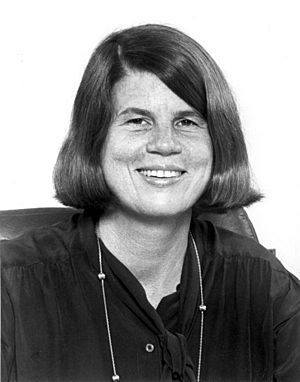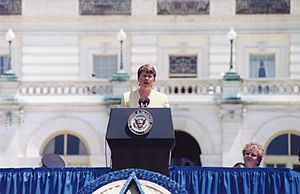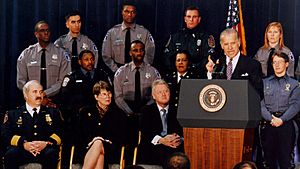Janet Reno facts for kids
Quick facts for kids
Janet Reno
|
|
|---|---|
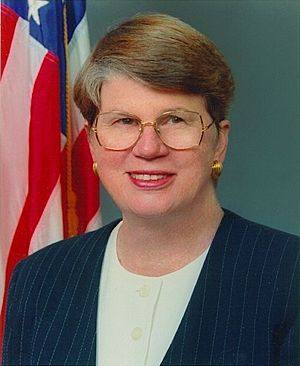
Official portrait, c. 1990s
|
|
| 78th United States Attorney General | |
| In office March 12, 1993 – January 20, 2001 |
|
| President | Bill Clinton |
| Deputy |
|
| Preceded by | William Barr |
| Succeeded by | John Ashcroft |
| State's Attorney for Miami-Dade County | |
| In office 1978–1993 |
|
| Preceded by | Richard Gerstein |
| Succeeded by | Katherine Fernandez Rundle |
| Personal details | |
| Born |
Janet Wood Reno
July 21, 1938 Miami, Florida, U.S. |
| Died | November 7, 2016 (aged 78) Miami, Florida, U.S. |
| Political party | Democratic |
| Education | |
| Signature | |
Janet Wood Reno (born July 21, 1938 – died November 7, 2016) was an American lawyer. She served as the 78th United States Attorney General, which is like the country's top lawyer and law enforcement officer. She held this important job from 1993 to 2001.
Janet Reno was the second-longest serving Attorney General in U.S. history. She was also the very first woman to hold this position. Reno grew up in Miami, Florida. After studying at Cornell University and Harvard Law School, she returned to Miami. There, she started her career in law.
Before becoming Attorney General, she worked for the state of Florida. She was elected as the State Attorney for Miami-Dade County five times. She was the first woman to be a state attorney in Florida. President Bill Clinton chose her to be Attorney General in 1993. She stayed in that role until President Clinton left office in 2001.
Contents
Early Life and Education
Janet Reno was born in Miami, Florida. Her mother, Jane Wallace, wrote for The Miami News. Her father, Henry Olaf Reno, was a reporter for the Miami Herald for 43 years. Janet had three younger siblings.
In 1943, her family moved to a house in South Miami. They had farm animals like cows, chickens, and goats. Janet helped her parents make butter to sell. This helped the family earn money.
When the family needed a bigger house, her mother, Jane, decided to build one herself. She learned masonry, electrical work, and plumbing. The family moved into the new house when Janet was 8 years old. This house was very important to Reno. She said it showed her that "you can do anything you really want if it's the right thing to do and you put your mind to it."
Janet Reno went to public schools in Miami-Dade County, Florida. After middle school, she spent a year in Germany with her uncle. She traveled around Europe during her breaks. When she returned to Florida, she became a debating champion. She was also the salutatorian at Coral Gables Senior High School.
In 1956, she went to Cornell University. She studied chemistry and became president of the Women's Self-Government Association. After Cornell, she went to Harvard Law School. She was one of only 16 women in a class of 500 students. She finished law school in 1963.
Early Career in Law
From 1963 to 1971, Janet Reno worked as a lawyer for two different firms in Miami. In 1971, she joined the staff of the Judiciary Committee for the Florida House of Representatives. The next year, she tried to get elected to Florida's state house but did not win.
In 1973, she worked on a project to update Florida's criminal procedure rules. Later that year, she joined the Dade County State Attorney's Office. The State Attorney, Richard Gerstein, soon made her his chief assistant. She left this office in 1976 to join a private law firm.
Becoming State Attorney
In January 1978, Florida Governor Reubin Askew appointed Janet Reno as the State Attorney for Dade County. This county is now called Miami-Dade County. She was the first woman to ever serve as a state attorney in Florida.
She was elected to the Office of State Attorney in November 1978. Voters re-elected her four more times. Reno was known for being ethical in her job. She even bought her car at the regular price to avoid any appearance of special treatment.
Her office handled many cases each year. She gained a reputation for being fair and honest.
Important Cases
In May 1980, Reno's office handled a case involving five police officers. They were accused of causing the death of a black insurance salesman. The officers were found not guilty. This led to protests and riots in Miami. Many people were upset. Reno met with her critics and later won re-election by a large margin.
Janet Reno personally did not support the death penalty. However, her office did secure 80 death penalty convictions during her time as State Attorney.
Serving as U.S. Attorney General
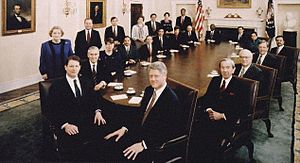

President-elect Bill Clinton wanted his team to represent all Americans. On February 11, 1993, he announced Janet Reno as his choice for United States Attorney General. His previous choices had faced issues because they had hired undocumented workers. Clinton chose Reno because of her experience as a State Attorney.
On March 11, 1993, the Senate approved Reno by a vote of 98 to 0. She was sworn in the next day. This made her the first woman to be the U.S. Attorney General. As Attorney General, Reno was in charge of the Justice Department and its 95,000 employees. She served for the rest of Clinton's presidency.
In 1994, Reno asked the Justice Department to study DNA evidence. She wanted to know how many wrongful convictions could be corrected with new DNA science. This led to changes in how eyewitnesses were interviewed and how labs worked.
Many important events happened during Reno's time as Attorney General:
- The 51-day standoff in Waco, Texas, involving the Branch Davidians. This event ended tragically with many deaths. Reno took full responsibility for the decision to end the standoff.
- A lawsuit against the software company Microsoft. The Justice Department said Microsoft was unfairly limiting competition. The case was settled later.
- The capture and conviction of Ted Kaczynski, known as the Unabomber.
- The capture and conviction of Timothy McVeigh and Terry Nichols for the Oklahoma City bombing.
- The capture and conviction of those involved in the 1993 World Trade Center bombing.
- An apology to Richard Jewell. He was wrongly suspected in the Centennial Olympic Park bombing due to a news leak. Reno said, "I think we owe him an apology."
- The armed removal of six-year-old Elián González from a relative's home. He was returned to his father in Cuba. Reno made this difficult decision.
Investigations During Clinton's Presidency
In 1994, Reno appointed a special lawyer to investigate President Clinton's business dealings in a case called Whitewater. This investigation found no link between Whitewater and the death of a White House lawyer. Later, another special lawyer, Ken Starr, took over the investigation.
In 1998, a committee in the House of Representatives wanted to hold Reno in contempt of Congress. This was because she did not release certain internal Justice Department memos. Reno said she refused to release them to protect the independence of prosecutors. The full House never voted on this.
Later Career and Legacy
After her time as Attorney General, Janet Reno ran for Governor of Florida in 2002. She lost in the Democratic primary election.
She then traveled the country giving speeches. She talked about improving the justice system. She believed that education needed to be better to help reduce crime. She also thought that juvenile courts needed more support to help troubled young people.
In 2004, Reno became a founding board member of the Innocence Project. This group helps prisoners who might be innocent, using DNA testing.
Personal Life
Janet Reno never married and did not have children. She learned Spanish while she was a state attorney. Even after being diagnosed with Parkinson's disease in 1995, she stayed active. She even learned inline skating in 1996. She lived in her childhood home her whole life.
Death
Janet Reno passed away from Parkinson's disease on November 7, 2016. She was with her friends and family. President Barack Obama praised her for her "intellect, integrity, and fierce commitment to justice." President Clinton thanked her for her "service, counsel, and friendship."
Awards and Honors
- Glamour magazine named Reno one of its "Women of the Year" in 1993.
- In 2000, Reno was inducted into the National Women's Hall of Fame.
- In 2008, she received the Council on Litigation Management's Professionalism Award.
- On April 17, 2009, she received the Justice Award from the American Judicature Society. This is the highest award given by the AJS. It recognized her work to improve justice and educate Americans about the law.
See also
 In Spanish: Janet Reno para niños
In Spanish: Janet Reno para niños
- List of female United States Cabinet members


